Upper Body Stretches
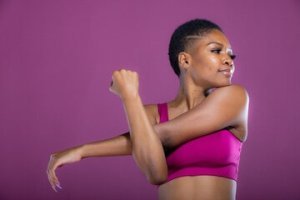
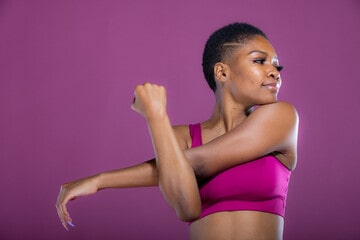
The upper body stretches on this page include step by step of how to do these exercises complete with pictures.
The muscles worked in these stretches include the biceps, triceps, forearms, shoulders, chest and even the neck muscles. So you will be working your arms, back, shoulders and chest with these body stretches.
You will want to warm up first before doing any stretching routines. This will help prevent tears and injury to the muscles.
List of Upper Body Stretches
Use the links below to go to the specific stretch or simply scroll through the page to see them all.
Upper Body Stretches - Biceps Stretch
As the name suggests, this step by step exercise instruction will stretch your biceps. The biceps brachhi are the muscles located in the upper front part of the arm. These are the ones you see when flexing and showing off the "big guns".
The two heads consist of the long and short head and work together as a flexor of the arm at the elbow. They also act as a supinator, or rotator of the forearm.
The biceps are the opposing muscles to your triceps. Whenever doing stretching or strengthening exercises, you want to work the opposing muscles. So once you are done with this stretch, be sure to do the next one for your tricep muscles.
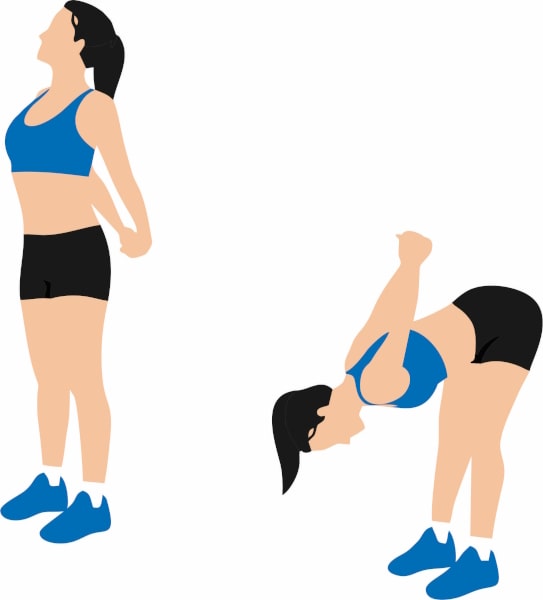
How to do the Biceps Stretch
- Stand with your feet slightly apart.
- Clasp your hands behind you.
- Bend at the waist.
- Lift your arms towards the ceiling, with hands still clasped.
- Hold this stretch for 15 - 30 seconds.
Here is another method of stretching your bicpes. You need to use a wall for this stretch so be sure to have the proper place in your home or at the gym for this one.
- Place your right hand on the wall and face sideways so that your arm is stretched out to your side.
- Make sure your palm is palm flat against the surface of the wall.
- Now slowly turn your body away from the wall until you feel the stretch in the bicep muscle.
- As you turn away from the wall, keep your arm straight.
- Hold this stretch for 20 - 30 seconds.
- Repeat for the other arm.
Upper Body Stretches - Triceps Stretch
With the triceps stretch exercise you will be stretching the opposing muscles of the bicep. These muscles are located at the back of the upper arm.
There are three muscle heads to this group which is why it is called triceps. These three heads are the lateral, long and medial head.
Running down the back of the arm is where you will find the long head. It is the largest of the three heads. The medial head, sometimes called the middle head, is located midline of the triceps. Lastly, the lateral head is located on the outside of the arm.
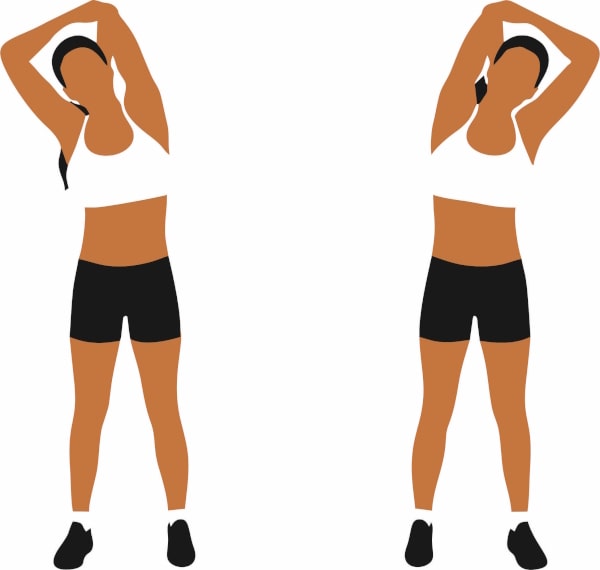
How to do the Triceps Stretch
- Stand with your feet hip width apart and knees slightly bent. You can also sit up straight in a chair.
- Bring your right arm straight up by your ear.
- Bend your arm at the elbow and drop right hand behind your back by your shoulder.
- Point the fingers down to touch the right shoulder blade.
- Bring your left arm up and around your head and grab hold of your right arm just below the elbow joint.
- Deepen the stretch by gently pulling back with your left arm until you feel the stretch in the triceps.
- Hold this for 20 - 30 seconds. Repeat for the other arm.
Tip: Try not to pull on the elbow joint while doing this exercise.
Upper Body Stretches - Forearm Stretch
These step by step instructions are for the forearm stretch. The forearm is located in the lower region of the arm between the elbow joint and wrist. There are many muscles in the forearm. These are broken down into two compartments; anterior and posterior.
The anterior, also known as the flexor compartment, are split into three muscle categories. These are the superficial, intermediate and deep muscles. The primary purpose of these are to allow flexion (or bending) at the wrists and fingers. The posterior compartment muscles are commonly known as the extensor muscles. This group is divided into two categories; deep and superficial. The primary function of this group is to extend (or straighten) the wrist and fingers.
How to do the Forearm Stretch
Below are steps to do 2 different types of stretches for the forearm. The first will stretch both arms at the same time while the second will stretch one are at a time.
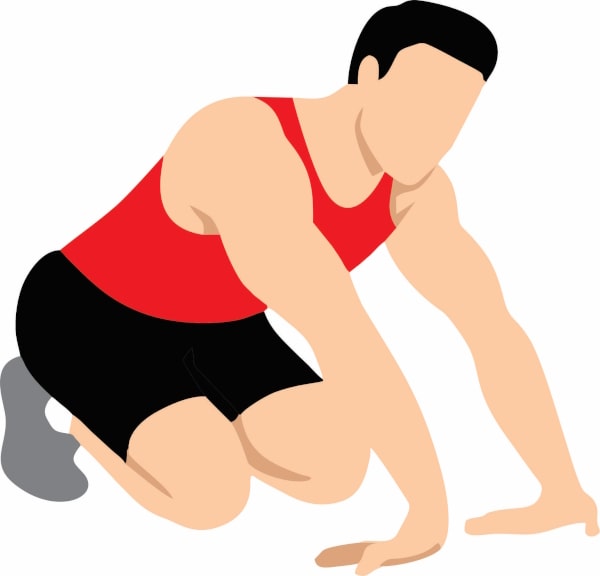
- Kneel down on an exercise mat.
- Place your palms flat on the mat with your fingers facing back towards you.
- Slowly lean back while keeping your palms flat on the floor until you feel a stretch in your wrists and forearms.
- Hold this stretch for 20 - 30 seconds
You can do this next stretch sitting or standing.
- Sit up straight in a chair.
- Place your right hand out in front of you with the palm facing toward the ceiling and elbow bent.
- Grab your fingers with your left hand.
- Slowly straighten out the right arm while holding the fingers pulling on the hand until the palms are facing out and away from you.
- Hold this stretch for 20 - 30 seconds.
- Repeat for the other arm.
Upper Body Stretches - Shoulder Stretch
With this shoulder stretch, you will be lengthening and toning the deltoid muscles. The deltoid muscle is a rounded, triangular shaped muscle found on the uppermost part of the arm and on top of the shoulder. This muscle is the widest at the shoulder and narrows as it moves down the arm.
The deltoid is the primary muscle of the shoulder and the primary target for this stretch. In addition you will also be helping keep your rotator cuff strong and healthy. The rotator cuff is a group of four muscles that are located between the scapula (shoulder blade) and the humerus bone (upper arm bone).
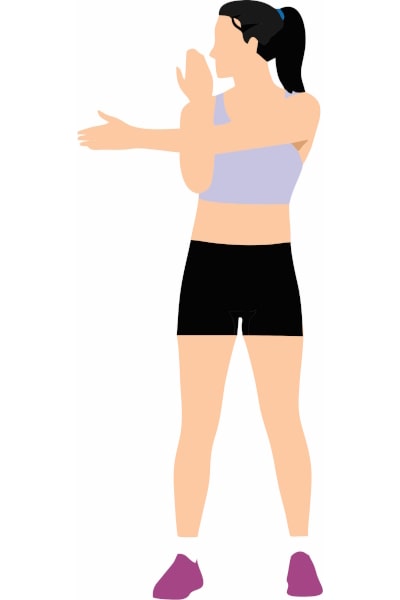
How to do the Shoulder Stretch
Below are step by step exercise instructions for the shoulder stretch.
- Standing up straight place your right arm out in front of you keeping it straight.
- Now bring it across your body.
- Take your left arm and place it under the right arm.
- Bend your left arm at the elbow and pull in slightly.
- Pull across the body until you feel the stretch in the upper part and back of the shoulder.
- Hold this stretch for 20 - 30 seconds.
- Repeat for the other arm.
Tip: Be sure to only stretch to the point of mild discomfort and not to the point of pain. Over stretching can cause small tears and injuries to the muscles.
Upper Body Stretches - Chest Stretch
The chest is made up of two primary muscles; pectoralis major and minor. The major, as the name suggests, is the largest of these two muscles and makes up the majority of the width of the chest. The pectoralis minor is located directly under the major. The primary purpose of these muscles are for movement of the shoulders and the stability.
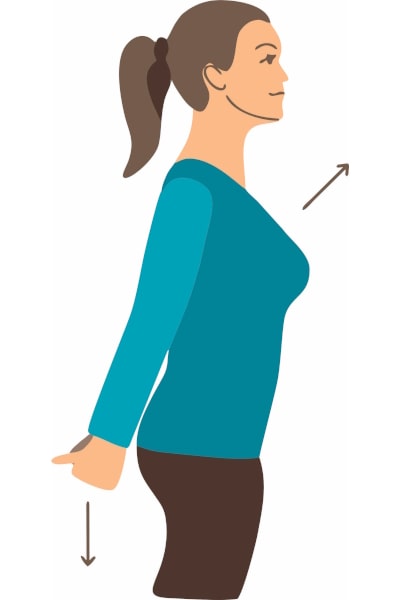
How to do the Chest Stretch
Follow along with the step by step instructions and illustration of this stretch.
- Standing up straight place your arms behind you and clasp your hands with palms together.
- Place your hands in the small of your back.
- Pull the elbows and shoulders back lifting up your chest.
- Extend your arms down (keeping the hands clasped together) to open up the chest.
- Hold this stretch for 20 - 30 seconds.
- Bring your chest back up and release your hands.
When the chest muscle is too tight, it can lead to shoulder and neck pain and can make take deep breaths difficult. By stretching the chest and activating the chest muscles, you stimulate blood flow and also increases your short-term range of motion and flexibility.
Upper Body Stretches - Neck Stretches
These are great stretches especially for those of you who sit at a computer or desk for long periods of time during the day. There are several different neck stretches below with step by step instructions.
How to do Neck Stretches
Since there are several different stretches, you will be working several different areas of the neck. All of these can be done either standing up or sitting up straight in a chair.
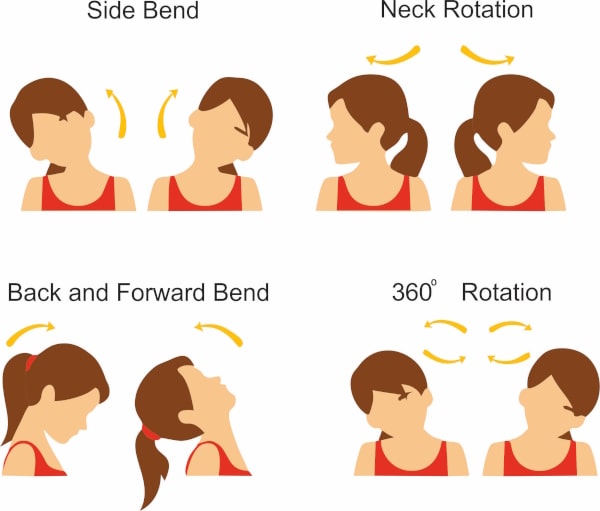
Stretch 1 - Side Bend
- Stand up straight with feet slighting apart, or sit down nice and straight in chair.
- Keep your arms at your side and shoulder and back straight.
- Bend your neck to the side dropping your ear towards your shoulder.
- Hold this stretch for 20 - 30 seconds and then repeat on the other side
Stretch 2 - Neck Rotation
- Stand up straight with feet slighting apart, or sit down nice and straight in chair.
- Keep your arms at your side and shoulder and back straight.
- Turn your head to the side keeping your chin up (don't bend the neck).
- Hold this stretch for a few seconds and then repeat on the other side. Repeat this for several reps.
Stretch 3 - Back and Forward Bend
- Stand up straight with feet slighting apart, or sit down nice and straight in chair.
- Keep your arms at your side and shoulder and back straight.
- Drop your chin to your chest and hold for a few seconds.
- Now bring your chin up and reach for the ceiling with your chin. Hold for a few seconds.
- Repeat this for several reps.
Stretch 4 - 360 Rotation
- Stand up straight with feet slighting apart, or sit down nice and straight in chair.
- Keep your arms at your side and shoulder and back straight.
- Rotate your neck a complete 360 degrees.
- Do this for several reps then switch directions and repeat for several more reps.
Benefits of Stretching
When pressed for time, many will often skip warming up, cooling down and stretching. These are all important steps to a full workout routine. Stretching not only helps keep the muscles healthy, there are many other benefits as well.
Relieving stress is one of these. With the hectic schedule many people have, stress comes into their life on a weekly (and even daily) basis. One way to relieve this is to stretch out the muscles in your body.
While this is a great benefit, it's not the only one. Stretching also improves your circulation. The better your circulation is the easier can heal injuries to the muscles. This type of exercise is also great for your posture. When you stretch, you are keeping the muscles loose. This helps improve posture and can reduce aches and pains.
Additional Articles
Lose Belly Fat
Doing abdominal exercises is great to tighten and tone the stomach. However,
if you have a layer of fat hiding those muscles, then you want to lose
that belly fat.
Upper Body Dumbbell Exercises
Check out these fitness exercises to strengthen the muscles in the upper
body. You can get strong, lean arms, chest, shoulders and more with
these workouts.
Resistance Band Exercises
Learn more about this type of equipment for your strength training.
Bands are inexpensive, easy to carry and provide enough resistance to
train your muscles.
